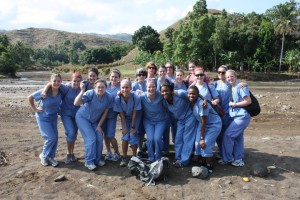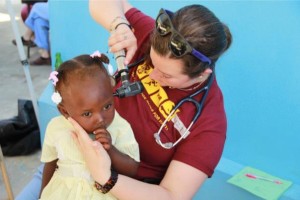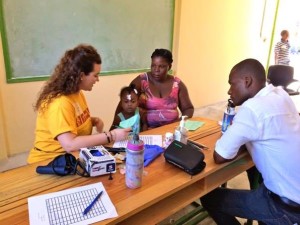February 3rd, 2016
Back to Basics – What the Patient Can Tell Us
Elizabeth Donahue, RN, MSN, NP-C
This was my sixth trip to Haiti, spending a little over a week in the city of Leogane and surrounding villages. It’s an area a few miles west of the capital city of Port Au Prince, bordering Carrefour, the site of the epicenter of the earthquake that shook the country’s foundation in January of 2010. During our time in Haiti, our main focus is running daily mobile outpatient clinics – this year a team of 25 nurse practitioners, nurses and students from the Boston College Connell School of Nursing provided care to just shy of twelve hundred patients.
In a profession where there are not always clear and concise answers (which I enjoy immensely, having a background in research and likely having worked on one too many regression analyses), I tend to find comfort in clinical settings among data. Here at home in the U.S., I have many tools that produce numbers that I can then use to assist in decision making: How much movement can I get on a patient’s A1c by adding one type of medication versus another? What was the most recent PHQ 9 score in this depressed patient? What did the sleep study show?
But each year, it is the work I do and witness in Haiti that reminds me that the numbers and data are just one piece of this very big clinical puzzle. The numbers are helpful tools, but they shouldn’t be the first ones we reach for and they often aren’t the source of the most important information – that comes from the patient themselves, either verbally or on exam.
On one of our first trips to Haiti, I remember a colleague caring for a patient with a high blood pressure – about 230/110 – not uncommon in Haiti though enough to make any provider start sweating. She looked at me and another NP and said – “where’s the EKG machine?” and my colleague who has made over 25 such trips broke into a wide grin, shaking her head in a “no” motion. She held her stethoscope above her head and replied “this is it.” The truth is that we won’t ever know if the patient has an old infarct or possible LVH. But after taking a very good history, performing a thorough assessment, and if possible repeating the evaluation in a brief and reasonable follow-up period, we can likely make the appropriate recommendations for management.
It can be hard to remember the power of a good history or a complete and thorough exam when we are used to the tools and technology that are constantly at our disposal in a well-funded clinical setting while caring for a well-insured patient. It can be even more difficult to resist using them when the patient is aware of them and is requesting these tests. Or worse, when we fear litigious repercussions. And there are certainly instances where their use is not only appropriate but essential. However, after spending two weeks caring for patients without a CT scan, ultrasound, or endoscopy, I am settling back into the idea that I should be careful and deliberate about the use of diagnostics and spend more time listening to both what the patient and the body has to say.

; [/php]/images/AU000_edonahue.jpg)




I could not agree more. As one who trained in the pre-CT era, my four one-month post-retirement surgical missions with MSF, one of them in Leogane, were rewarding returns to those more basic days. Surgical judgment was based on the H&P rather than dozens of labs and films. By and large, the patients did well. It is my hope that most medical students and residents will at some point spend time in a third world setting. It is humbling and it really changes one’s perspective on diagnosis amd treatment.
The time spent in taking a good history is always well worth, as it often prevents expensive disasters for the patient (and embarrasment for the treating physician) in both the near and distant future. After all, the patient knows his / her body signals the best, so it is worth listening to them uninterrupted.
Unfortunately, history taking is a dying art world wide!